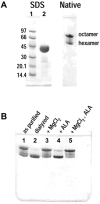Probing the oligomeric assemblies of pea porphobilinogen synthase by analytical ultracentrifugation
- PMID: 18795796
- PMCID: PMC2559947
- DOI: 10.1021/bi801128d
Probing the oligomeric assemblies of pea porphobilinogen synthase by analytical ultracentrifugation
Abstract
The enzyme porphobilinogen synthase (PBGS) can exist in different nonadditive homooligomeric assemblies, and under appropriate conditions, the distribution of these assemblies can respond to ligands such as metals or substrate. PBGS from most organisms was believed to be octameric until work on a rare allele of human PBGS revealed an alternate hexameric assembly, which is also available to the wild-type enzyme at elevated pH [Breinig, S., et al. (2003) Nat. Struct. Biol. 10, 757-763]. Herein, we establish that the distribution of pea PBGS quaternary structures also contains octamers and hexamers, using both sedimentation velocity and sedimentation equilibrium experiments. We report results in which the octamer dominates under purification conditions and discuss conditions that influence the octamer:hexamer ratio. As predicted by PBGS crystal structures from related organisms, in the absence of magnesium, the octameric assembly is significantly destabilized, and the oligomeric distribution is dominated largely by the hexameric assembly. Although the PBGS hexamer-to-octamer oligomeric rearrangement is well documented under some conditions, both assemblies are very stable (under AU conditions) in the time frame of our ultracentrifuge experiments.
Figures





References
-
- Battersby AR. Tetrapyrroles: the pigments of life. Nat Prod Rep. 2000;17:507–26. - PubMed
-
- Kervinen J, Dunbrack RL, Jr., Litwin S, Martins J, Scarrow RC, Volin M, Yeung AT, Yoon E, Jaffe EK. Porphobilinogen synthase from pea: expression from an artificial gene, kinetic characterization, and novel implications for subunit interactions. Biochemistry. 2000;39:9018–29. - PubMed
-
- Breinig S, Kervinen J, Stith L, Wasson AS, Fairman R, Wlodawer A, Zdanov A, Jaffe EK. Control of tetrapyrrole biosynthesis by alternate quaternary forms of porphobilinogen synthase. Nat Struct Biol. 2003;10:757–63. - PubMed
-
- Jaffe EK, Ali S, Mitchell LW, Taylor KM, Volin M, Markham GD. Characterization of the role of the stimulatory magnesium of Escherichia coli porphobilinogen synthase. Biochemistry. 1995;34:244–51. - PubMed
-
- Frankenberg N, Erskine PT, Cooper JB, Shoolingin-Jordan PM, Jahn D, Heinz DW. High resolution crystal structure of a Mg2+-dependent porphobilinogen synthase. J Mol Biol. 1999;289:591–602. - PubMed
Publication types
MeSH terms
Substances
Grants and funding
LinkOut - more resources
Full Text Sources
Other Literature Sources
Research Materials

